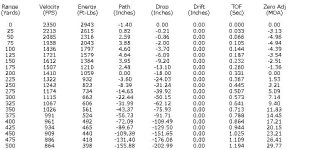Lets try a slightly different approach.
This is a chart of the 2 sets of numbers, each is color coded to its data.
I read the 2 sets as
"This is the actual drop from your 200 yard zero" but at a distance of 100yds.
These are the MAGENTA numbers & tracks.
"This is the amount below the line of sight you bullet will be at theses distances with a 200 yd zero"
These are the Blue colored numbers & tracks
(Note although it says "100 yd" the actual "0.00" is at the 200 yd range in both tables.)
(Images (C) Wogpotter 2015)

Why have both sets?
Easy!
For different methods of aiming off for distances other than the zeroed 200yds where the path is 0.00" in both cases.
If you're gong to adjust your Point of aim by clicking the scope knobs this is how much you change it (with a 1/4" click for 100 yds you multiply by 4@ 100 2 @ 200 & so on.)
That's the BLUE numbers.
If instead of twiddling you aim off by the opposite amount then you use the Magenta ones.
Rephrased as:
"To hit dead on with your 200 yd zero aim 39" high at a distance of 500 yds.
This is a chart of the 2 sets of numbers, each is color coded to its data.
I read the 2 sets as
"This is the actual drop from your 200 yard zero" but at a distance of 100yds.
These are the MAGENTA numbers & tracks.
"This is the amount below the line of sight you bullet will be at theses distances with a 200 yd zero"
These are the Blue colored numbers & tracks
(Note although it says "100 yd" the actual "0.00" is at the 200 yd range in both tables.)
(Images (C) Wogpotter 2015)

Why have both sets?
Easy!
For different methods of aiming off for distances other than the zeroed 200yds where the path is 0.00" in both cases.
If you're gong to adjust your Point of aim by clicking the scope knobs this is how much you change it (with a 1/4" click for 100 yds you multiply by 4@ 100 2 @ 200 & so on.)
That's the BLUE numbers.
If instead of twiddling you aim off by the opposite amount then you use the Magenta ones.
Rephrased as:
"To hit dead on with your 200 yd zero aim 39" high at a distance of 500 yds.

